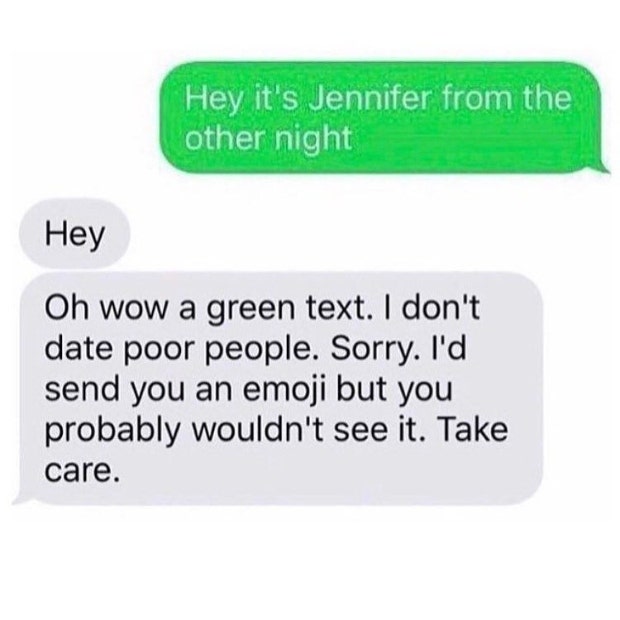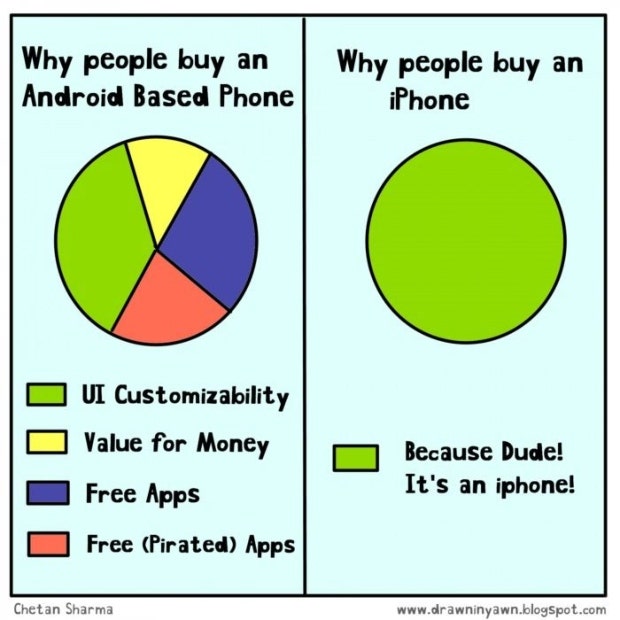The Shady Reason IPhone Users See Texts From Androids In Green Bubbles Instead Of Blue
The shade matters more than you may think.
 Getty / 32 pixels / Shutterstock
Getty / 32 pixels / Shutterstock iPhone users know that if they send a message to someone whose response comes in as a green text, they’ve reached an Android user.
While at first thought it makes sense that a device using a competing operating system wouldn’t use Apple’s messaging system, one TikTok user has pointed out how low-key shady the Android green texts are.
Does Apple put texts from Android users in green bubbles as a psychological trick?
TikToker Ryan McNeill, who goes by the handle @invisible_influence, posted a TikTok explaining how “manipulative” Apple’s decision to make Android messages come in green bubbles actually is. So manipulative, in fact, some people refer to the practice as a form of bullying.
“This green is a social trigger to our tribal brains,” he says, explaining that humans strive to belong.
Studies have shown that we tend to gravitate towards people who are similar to us and take longer to warm up to those who are different from us.
“When we see this green color pop up in our text threads, it immediately sends a signal that this Android freak is an outsider and makes us subconsciously think less of them for it,” says McNeill.
The Android green bubbles have indeed divided the internet, sparking many memes.
There are memes dedicated to poking fun at Android users, with iPhone users claiming to be superior.

There are definitely still some Android strongholds out there, though, who realize that, for the price, the functionality of the Android operating system is by far the better buy.

Whether or not the green text is a subliminal marketing ploy by Apple to get Android users to switch over to iPhone to feel that sense of belonging, the green texts do have a technical background.
Green texts are text messages sent on a different network.
Apple first released the iMessage platform with iOS 8 in 2011. It differed from traditional SMS text messages in that iMessages were sent over data networks (such as WiFi, or cellular data if you’re not connected to WiFi) instead of voice networks.
Because Apple uses its own encrypted servers to relay iMessages, devices using operating systems outside of those servers (i.e. Android) cannot decrypt iMessages and instead they get sent over the SMS voice networks like traditional text messages.
That said, Apple users can also deactivate iMessage. If they choose to do so, their messages will also be sent over voice network and appear in green bubbles, so jumping to conclusions about the color of text messages may lead you in the wrong direction.
Despite (or perhaps as a way to combat) the competition, Google recently released a feature to unite iPhone and Android users.
The different colored bubbles will remain. However, Google recently released an operating system update that will at the very least let Android users see the reactions iPhone users send.
Those using iMessage are able to react to other iMessages with emojis that show up for the other users in the message thread. Before the Android update, Android users couldn’t actually see the Apple emojis.
For example, when one Apple user “loves” another Apple user’s message, a heart shows up on that message. But when one Apple user “loved” an Android user’s message, Instead, text saying “Loved your message” would come through.
With the new update, Android users will now be able to actually see the corresponding emoji.
These days, smartphones are more alike than ever.
While Apple was once a smartphone pioneer, other companies have since caught up with and even surpassed the iPhone.
Aside from the green and blue texts, most phones are one and the same. Price points of smartphones aren’t far off from one another, camera quality is impeccable on all phones, and even the similar design of phones makes it difficult to differentiate one brand from another.
And if the different text colors really bother you, there are always other third-party messaging apps that work exactly the same on both types of phones.
Micki Spollen is an editor, writer, and traveler. Follow her on Instagram and keep up with her travels on her website.

